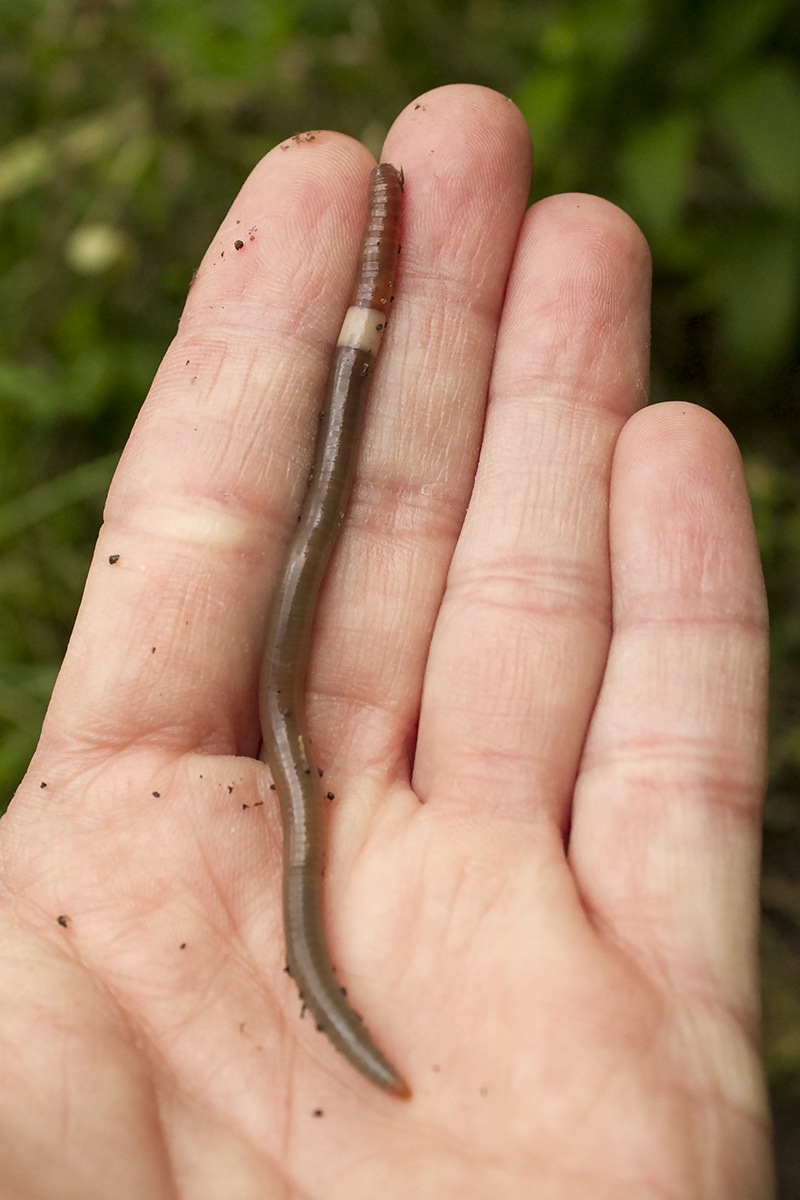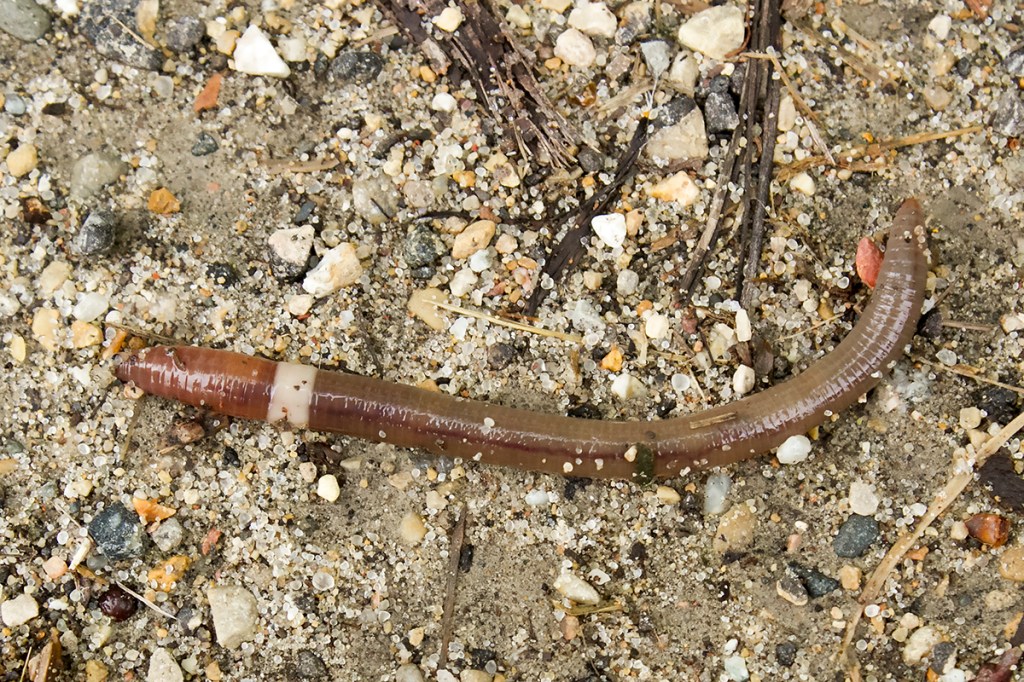Disturb a jumping worm and it’s like a nightcrawler on steroids: It violently writhes on the forest floor, recalling a snake in a bad horror movie. Try to catch it, a piece of its tail will detach in your hand — still wriggling as you hold it.
But put aside the creepy factor: jumping worms may be the next big threat to northern forests.
Jumping worms, consisting of various non-native species from multiple genera, have become established in a number of eastern and southeastern states. In 2013, species from the genus Amynthas were confirmed for the first time in the Upper Midwest, at the University of Wisconsin-Madison Arboretum.
In the forests and prairies of the Upper Midwest, the jumping worm could significantly alter habitats and decrease biodiversity. Why are they so damaging? And is there anything we can do to stop them?
Why Much of What You Know About Earthworms is Wrong
You probably learned about the wonders of earthworms at an early age. They aerate the soil. They help your garden grow. And they catch fish. The humble earthworm is a creature to celebrate.

Overlooked in all this earthworm love is an important fact: in a significant portion of the North American continent, no native earthworms have existed since before the Ice Age. As such, forests and other habitats have evolved without them.
But people love earthworms. They indeed use them by the millions for fishing, and for composting, and to help gardens grow. And so the worms have been spread far and wide. Even areas with native earthworms have largely been taken over by non-native varieties. The common nightcrawler — familiar to anyone who has ever cast a bobber and hook — is a European species.
Earthworms have also spread into the northern habitats where worms have been absent for thousands of years. The hype is true: earthworms cycle through a lot of refuse, and fundamentally change the soil. This may be good in your backyard garden plot, but it’s not in the northern forest.
“Earthworms change the environment to suit their needs,” says Brad Herrick, ecologist and research program program manager at the University of Wisconsin-Madison Arboretum. “When they are introduced, they make a host of physical, chemical and biological changes to the soil environment.”
Essentially, worms turn the forest floor — a complex community of plants, invertebrates and microbes – into a completely different habitat.
The jumping worm, if established in the Upper Midwest, brings new threats. “We think the changes to native habitats will be similar to other earthworms but even more dynamic,” says Herrick.
Spread of the Jumping Worm
You probably think of earthworms as living underground. But the jumping worm actually lives in the topmost layer of the forest floor — amongst the fallen leaves and other material that cover the soil. It eats that fallen organic material. And that’s the problem.
That leaf litter provides essential nutrients to the forest. Trees need long-lasting sources of nutrients. When jumping worms quickly turn leaves into very loose soil (resembling coffee grounds), they deprive trees of essential nutrients.
They thus can inhibit the establishment of tree seedlings. The altered soil is inhospitable to many native plant species. And that soil also disrupts the relationships between fungi and trees.
In short, the jumping worm could have profound effects on the overall forest ecosystem.
As with so many invasive species, they’re adaptable and difficult to stop. They’re parthenogenetic: they can reproduce without fertilization. The introduction of a single individual is enough to launch a jumping worm invasion.
The worms have an annual life cycle. They die in the fall, but leave tiny cocoons that spend the winter in the soil.
And they can be spread readily by human habits. Take their preferred habitat of fallen leaves. At this time of year, many people are raking leaves into a pile and setting them by the road to be picked up or converted into mulch. The worms — or their cocoons — are thus transported to new habitats. Compost and potted plants can also move the worms around.
“Unfortunately at this time, there are no good control measures,” says Herrick. “The important thing now is to the stop the spread. Everyone can help.”
Stop the Jumping Worm
Herrick and other conservationists agree that prevention is the most effective tactic. If you live in the Upper Midwest, and see a writhing, snake-like earthworm in your backyard, report it to your state natural resources department. (In Wisconsin, you can email invasive.species@wi.gov to report sightings).
The Wisconsin Department of Natural Resources also has a handy identification card to help you distinguish the jumping worm from the common nightcrawler.
Wisconsin DNR also suggests examining potted plants and gardening and landscaping materials for the presence of jumping worms. If you are doing landscaping and gardening work, be sure to clean your equipment and clothing to prevent transporting cocoons.
And if you buy compost, only buy from sources that heat the compost at appropriate temperatures and duration to kill pathogens.
The jumping worm is not yet established in much of the northern United States. The time is now to keep it from becoming the next invasive species horror story.




I am part of a conservation and restoration group here in Oregon, and I see how damaging this could be. Thank you for this information!
According to the Wisconsin DNR these worms are native to SE Asia. Great article, but I was itchin’ to find out where they came from.
Thanks for saving some of us the time and contributing to the conversation in a constructive way.
I live in Virginia. Are there reports off jumping worms here? Where may I gol for information?
Thanks
Are there any native predators that would be effective in controlling spread of the Jumping Worm?
Is this similar to the red wiggler?
I have the same question
Red wigglers were given to me by gardening program for use in a worm bin. Some have escaped into my garden.
Ditto me. I’ve been looking everywhere to see what makes these worms different & worse than your standard manure worm, & nobody seems to have an answer. I’d also be interested to know if there’s any evidence that these worms actly do kill forests, or whether we’re just worried that they could. Any good studies using good scientific methods that I could read? TY.
Good article. Thanks for the alert.
I have learned so much from reading from your blog. I find the more I learn the more I want to learn about the interesting, exciting, and concerning environmental issues that affect our world. Thank you so much because I want to know even more.
I deliberately placed worms in my earth 30 years ago because of poor soil, now it is richer and turned dark. Everything grows better.
There are about 2,700 species of earthworms, each of which is evolved to live in a specific place, with its own parasites and predators. Pick one up and plop it down somewhere else and it has the potential to act as a disease with no checks. Without the population controls where it came from, there is nothing to keep the population from being a problem. This is why invasive species are such so difficult and expensive to deal with…oh and the is that problem when people don’t understand the impacts of what they are doing…like the person who introduced English sparrows, or the road engineer who thought Rosa multiflora would be good along the road sides.
I think you may mean European Starlings not sparrows, but maybe sparrows are also an issue.
Or European(aka”Himalayan”) blackberry brambles, basically they have overwhelmed and destroyed every unmanaged open space in lowland western Washington, property owners have mostly given up since the state noxious weed department not only stopped fining landowners(or even taking care of their own lands) and allowed the seed-banks to explode exponentially but even allows dishonest nurseries to sell the plants.
The wild butternut is under threat both from disease and hybridizing with some imported asian nut.
then you have the imported softshell clams(not even good to eat) displacing all the natives, feral(and domestic) cats are a problem world wide, Holly bushes, english ivy, morning glory, escaped “atlantic salmon”, and many more
The problem will just get worse with people trading plants on ebay.
I really think that bothering to slow the spread of something as established as these worms is a wasted effort, in a case like this any solution that doesn’t completely wipe them out and check new importation is totally futile. (It is plausible in some cases, malaria was eliminated from the mainland USA some decades ago with mosquito controls.)
House sparrows are, in fact, even more invasive than Starlings. Earl Shields, in his excellent book “Raising Earthworms for fun & profit” has a famous chart of how fast earthworms reproduce & could spread. He also points out that they generally don’t.
Can these worms live in an environment where we may not get a hard freeze for a couple of years, like here in the Pacific Northwest? Where did these worms originate?
I had a horrific experience with these worms a few years ago in Florida. My husband and I returned from a trip and found a terrible stench in the house when we entered into it again. I followed the smell and thousands of these worms were hanging from the sliding door frames and writhing on the patio and had entered through the tracks of the sliders into the house. It was a horror movie!! I callled everyone I could think of to help, even the police. No one had ever heard if a similar event. Our house was on a large property adjacent to a golf course, lots of acreage and soil all around our home. No one came to help. My husband and I had to overcome our revulsion and nausea and sprayed the worms pesticides and 409 and had to hose them off the sliding doors and tracks and tile stone floor in the living room and outside on the patio. My poor husband used a shovel to place them in plastic bags and sealed those and disposed of them. They never appeared again after that , but it was a nightmarish experience.
It would be great to know what nematodes and viruses are possible controls.
We have serious invasive slug problems too, and many of them eat duff and seedlings. They too might be controlled with nematodes.
Listen, you may be right about this worm but I am WAY more worried about Trump’s impact on the environment just now! Thanks you the interesting info though!
I hear you! But please, take a deep breath and go outside…refuse to let the politics intervene with good work you can do in your own back yard 🙂 Good luck…I wake up in the AM feeling like I have an elephant sitting on my chest…oh wait, I do!
And do your yard a favour, don’t rake the leaves.
Writhing like snakes and changing soil habitats is what ALL worms do.
Then perhaps you might consider that you are not paying close enough attention to give a darn about the future of forests? The natural world is complex and nuanced. We need to understand that to save ourselves.
Great reporting and keep up the good work. We need more reports like these that are science-based. It does make me wonder what the next ecological horror will be.